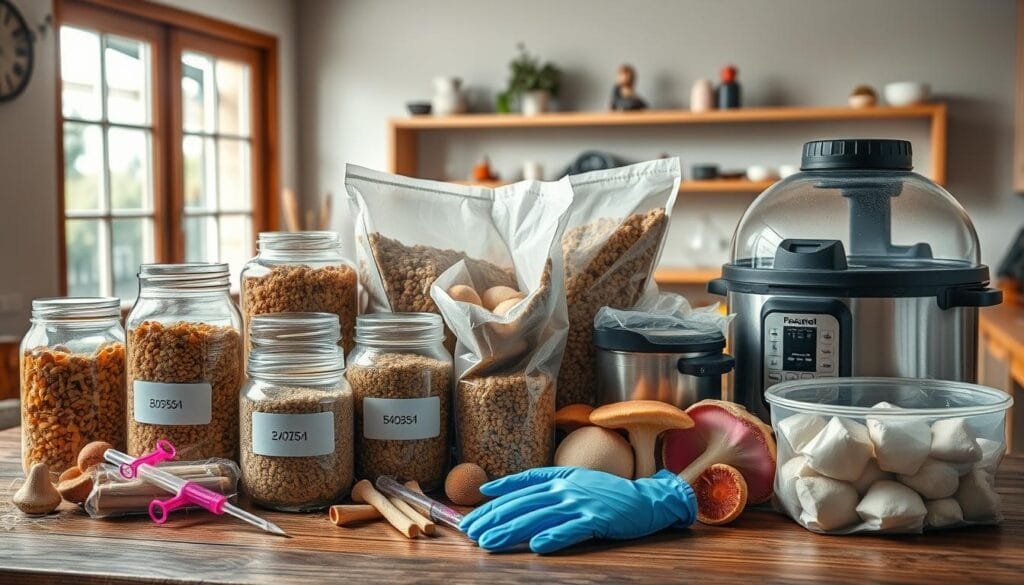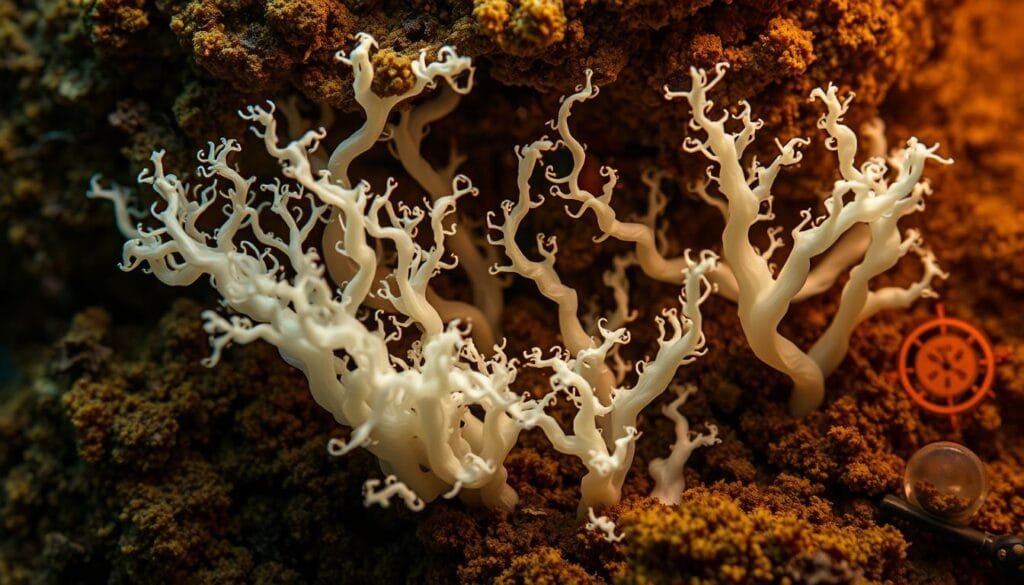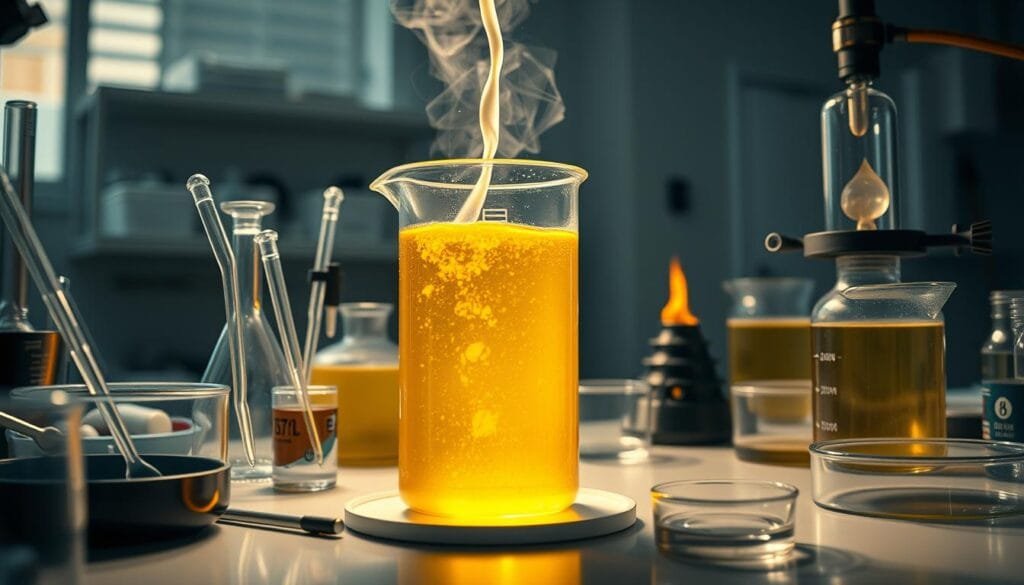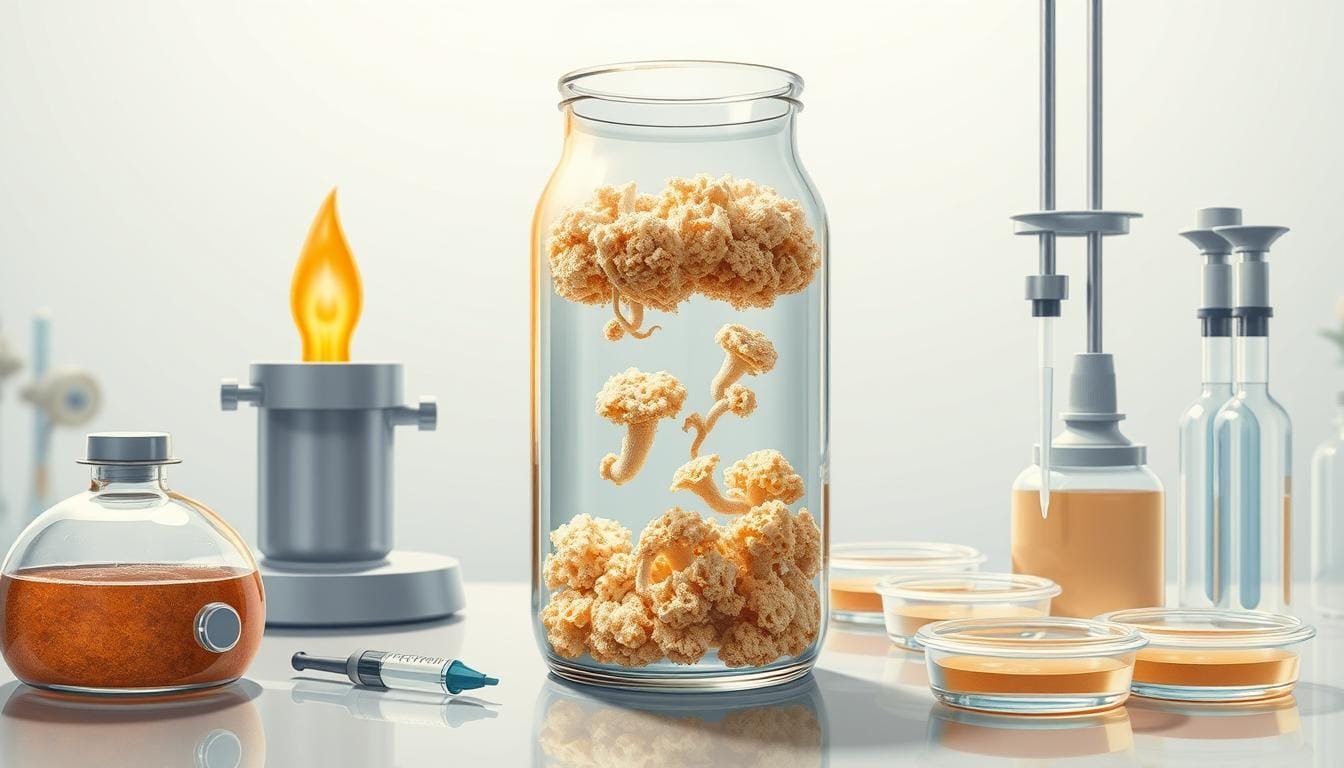Have you ever thought about making your mushroom growing simpler? Want to cut down on contamination and save money? Our detailed guide on liquid culture is your answer. It helps your mushroom cultivation move faster and gives you better results.
In this guide, we’ll look at the liquid culture method. It’s a nutrient-filled solution that helps mushroom mycelium grow. It makes inoculating grain spawn easier. This guide is great for experienced growers and beginners. You’ll learn how to use this method effectively.
Key Takeaways
- Liquid culture speeds up mushroom growth.
- It lowers the risk of contamination compared to using spores.
- Growers can save money with liquid culture.
- The right sugar-to-water mix is crucial for a good culture solution.
- Keeping everything sterile is key to avoid contamination.
- The best incubation temperatures are between 70-80°F for strong mycelium growth.
- A good liquid culture setup can see mycelium growth in just a few days.
Follow these steps for a successful mycelium culture with less work. For an in-depth guide, check out our full article here.
Introduction to Liquid Culture
Mushroom cultivation is a rewarding hobby, especially with advanced techniques. Liquid culture is a key method for growing mushroom mycelium successfully. It makes the cultivation process both efficient and easy to manage.
What is Liquid Culture?
Liquid culture is a nutrient-rich suspension for mushroom mycelium. It’s like a garden for mushrooms to grow, using sterilized water and sugars. These sugars can be organic honey, corn syrup, light malt extract, or dextrose. Agitating the culture daily helps mycelium grow well.
Preparing and keeping an eye on your liquid culture is vital. It helps your mushrooms start off strong.
Benefits of Liquid Culture in Mushroom Cultivation
Using liquid culture has lots of benefits. It’s not just easy to prepare, but it also cuts down on the need for lots of equipment and grain spawn costs. It’s great for both beginners and experienced growers.
This method speeds up the growth process. Incubation only takes 10 days to 3 weeks. Plus, mushrooms grow faster and stronger, usually within 14-45 days.
Essential Equipment and Ingredients
To make a successful mushroom liquid culture, you need the right tools and ingredients. This helps mycelium grow well and cuts down on contamination risks.
Key Ingredients for Liquid Culture
Choosing the right ingredients is key to a good liquid culture. You will need:
- Light Malt Extract: 10 grams per 500 ml of water. It provides the carbs mycelium needs to grow.
- Yeast: About 1 gram per 500 ml of water. It gives vital nutrients to the mycelium.
- Honey or Corn Syrup: A 4% solution, or 12 grams for 300 grams of warm water. It offers a balanced source of carbs.
These ingredients help the mycelium grow strong and efficiently.
Tools and Equipment You’ll Need
The right tools are just as crucial as the ingredients. You will need:
- Digital Scale: Necessary for accurate measurements.
- Mason Jars with Mycology Lids: Quart-sized jars are perfect. They have enough space for nutrient broth and easy inoculation.
- Pressure Cooker: Needed to sterilize jars and tools. Keep it at 15 psi for 15 to 20 minutes to kill all microorganisms.
- Sterile Syringes: Used for handling liquid culture safely.
- Airport Lids: They allow air exchange while preventing contamination.

Having the right supplies and sterilization equipment is crucial. They help maintain a clean environment for mushroom cultivation. Good preparation and sterilization practices are key.
Knowing and using essential cultivation supplies properly is important. It helps ensure our mycelium grows well. This prepares us for successful grain inoculations and future mushroom growth.
Understanding Ratios and Proportions
Learning the right sugar-to-water mix is key to growing liquid culture. This balance helps mycelium grow best. We’ll look into basic sugar-to-water mixes and test different sugars.
Optimal Sugar-to-Water Ratios
The perfect sugar-to-water balance is crucial for mycelium to thrive. A typical rule is mixing 1 gram of light malt extract with 600 milliliters of water. For honey users, the go-to is 24 grams per 600 milliliters of water, roughly 4% sugar. This mix helps mycelium grow strong.

Being precise with these amounts makes sure mycelium gets the right nutrients. Wrong mixes may give too little or too much nutrients, affecting mycelium growth.
Experimenting with Different Sugars
Trying different sugars can lead to new discoveries. Besides light malt extract and honey, there’s dextrose, sucrose, and molasses. Each sugar has its pros and cons. For example:
- Honey: Brings natural enzymes and fights bacteria.
- Dextrose: Mycelium uses this simple sugar easily.
- Sucrose: Common, but mycelium might need to work harder to use it.
- Molasses: Full of nutrients but hard to filter clearly.
Here’s a table showing different sugars for liquid culture:
| Sugar Type | Attributes | Considerations |
|---|---|---|
| Honey | Natural enzymes, antibacterial | Must maintain proper sugar-to-water ratio for optimal results |
| Dextrose | Simple sugar structure | Easily metabolized by mycelium |
| Sucrose | Widely available | May require processing by mycelium |
| Molasses | Rich in micronutrients | Challenging to filter sterilely |
Using these sugars and keeping the best sugar-to-water mix, cultivators can customize their liquid culture. This boosts mycelium growth and helps mushroom cultivation succeed.
Preparing the Liquid Culture Solution
We aim to create the perfect environment for mycelium growth when making liquid culture. This means getting the ratios right, mixing well, and keeping everything sterile. Let’s look at the key steps.
To start, we dissolve sugar in water to make a nutrient-rich broth. A common starting point is a 4% solution nutrient broth. For example, we might use 20 grams of light malt extract per liter of distilled water.

It’s essential to mix the solution well. Using a magnetic stir bar helps a lot. This tool keeps the liquid culture moving on a magnetic plate. It ensures an even spread of nutrients and stops mycelium from clumping.
Let’s dive into the mix of ingredients and their amounts:
| Ingredients | Quantity |
|---|---|
| Warm water | 300 grams |
| Light corn syrup | 12 grams (4% concentration) |
| Light malt extract | 20 grams (per liter) |
| Distilled water | 1 liter |
| Magnetic stir bar | 1 piece |
Next, we sterilize the mix. This usually means using a pressure cooker at 121°C (250°F) and 15 psi for 15 minutes. This method keeps our liquid culture sterile and prepped for the next step.
Cool the liquid culture before adding mycelium so it doesn’t get damaged. Keeping it at 20-25°C (68-77°F) helps mycelium grow fast and strong.
Shaking the jars gently every few days helps mycelium grow evenly. This is vital for consistent mushroom growth. Using airtight containers stops contamination and reduces evaporation, especially when storing.
Now that our liquid culture solution is ready, we can move to the inoculation phase. We’ve set up a great environment for mycelium to thrive.
How to Perform a Liquid Culture
Successfully performing a liquid culture for mushroom cultivation involves several critical steps. Each phase is key to avoid contamination and get the best results.
Step-by-Step Preparation
Start by mixing your ingredients. You can use 1 gram of light malt extract or 24 grams of honey per 600 milliliters of water. Make sure everything is completely mixed. Adding 1 gram of brewer’s yeast per liter enhances the nutrients.
Next, set up the pressure cooker. Put about 1 inch of water around the jars. Your solution goes into mason jars or media bottles, with lids loosely on to balance the pressure.
Sterilization Process
It’s crucial to sterilize correctly to keep everything clean. Sterilize at 15 PSI for 20 minutes. This step kills harmful germs and lowers contamination risk.
Inoculation Techniques
After sterilization, let the jars cool. Use a clean syringe to measure 1-2 milliliters of liquid culture for a quart-sized grain jar. For a 5-pound grain bag, use 5-10 milliliters. Keeping tools and areas clean is vital to avoid contamination.
Incubation and Growth Monitoring
Then, incubate the jars at 21-26 degrees Celsius (70-80 degrees Fahrenheit). This is the best temperature for mycelium growth. Within 10-14 days, healthy mycelium looks clear with blobs. If it’s cloudy or changes color, it might be contaminated and need disposal.
In summary, clean techniques are essential for liquid mushroom cultures. Good sterilization and clean inoculation lead to better mycelium growth. Follow these steps for successful mushroom cultivation.
Identifying Healthy vs. Contaminated Liquid Culture
In mushroom growing, knowing the difference between healthy and contaminated culture is key. It ensures your culture works well from start to finish. Here are some tips to spot if your liquid culture is healthy.
Signs of a Healthy Liquid Culture
For mushroom growers, keeping a healthy mycelium culture is crucial. At first, a healthy culture may look a bit cloudy. This is due to minor bacteria presence but it clears after 72 hours as mycelium takes over. Mycelium should grow fast, which is a good sign.
When mycelium starts growing, the liquid becomes clear. This means it’s ready to use. Healthy mycelium can fight off bacteria. It uses its evolutionary edge, honed over millions of years.
- Clear liquid with minimal, initial cloudiness
- Rapid mycelium growth within 12 hours
- Absence of unusual odors
- No sediment or unusual particles
- Uniform mycelial growth patterns
Detecting Contamination
Spotting contamination early in liquid culture is vital. Bacterial contamination is marked by ongoing cloudiness, even with mycelium growth. Molds look like small cotton balls or tangled tendrils. They might be black or green. Other signs are off-gases, sediment, and bad smells.
- Cloudiness that does not clear after several days
- Color changes to yellow, green, or pink
- Presence of sediment or floating particles
- Mold displaying fuzzy or irregular patches
- Gas bubbles or foaming in the culture
- Strong, putrid smells resembling decay
- Sour or vinegary odors indicating spoilage
To avoid contamination, handle spores in clean places like glove boxes or flow hoods. If contamination happens, isolate the culture right away. Dispose of it properly to protect the environment. Healthy mycelium and watching for signs of contamination lead to better mushroom growing.
Using Liquid Culture for Grain Inoculation
Using liquid culture correctly is key to great grain spawn inoculation. By spreading mycelium-infused liquid into sterilized grains, you boost efficiency. This method helps mushroom cultures grow well.
It’s important to mix the right amount of sugar and water in your liquid culture. A mix with 4% beet sugar works best for mycelium. After making this solution, you sterilize it for 2 hours. Keeping the liquid at 20°C is best for spreading the mycelium.
You should shake the liquid culture every few days after sterilizing it. This evens out the mycelium. For oyster mushrooms, let the culture sit for about 14 days. Shaking the jar before using it on grain helps the mycelium spread everywhere.
- Prepare the liquid culture with the right sugar level.
- Sterilize the solution for two hours.
- Shake the culture during the incubation period.
- Inoculate sterilized grains with the prepared culture.
To inoculate grains, 1-2 ml of liquid culture per quart-sized jar works well. For a 5 lb bag of grain, use 5-10 ml. Following these steps helps:
| Step | Duration/Quantity | Details |
|---|---|---|
| Boiling Time for Sterilization of Grains | 3 hours | Ensure grains are boiled properly. |
| Calcium Carbonate Addition | 2-5% of grain weight | Helps with grain pH balance. |
| Inoculation Volume for Quart-Sized Jars | 1-2 ml | Makes mycelium spread evenly. |
| Incubation Time for Colonization | 14-45 days | Watch grains for mycelium growth. |
| Storage Temperature | 20-23°C for 3 weeks | Best conditions for inoculated grains. |
We always watch the grains for any signs of contamination, like unusual colors. Liquid culture gets faster, more reliable results than spore inoculation. It’s a cost-effective way to grow mushroom cultures.
Conclusion
As we wrap up, our detailed guide on liquid culture has given you the key steps. It covers preparing the solution and the right sugar-to-water ratios. It also explains how to master inoculation techniques and track growth.
Liquid culture is a big help in growing mushrooms, saving time and money. It speeds up colonization and is cheaper than buying grain spawn. This makes it a top choice for hobbyists and commercial growers alike.
In short, using liquid culture means better and faster mushroom growth. This guide shows how to improve your growing methods for top-quality mushrooms. Remember, good liquid culture leads to strong mushroom growth. It’s worth the effort you put in.
FAQ
What is Liquid Culture?
Liquid culture is a rich solution used to grow mushroom mycelium. It’s a sterile mix that helps mushrooms grow. This method is great for starting grain spawn and is faster and more reliable than spore inoculation.
What are the benefits of using liquid culture in mushroom cultivation?
Liquid culture has many benefits. It’s cheaper, simple to prepare, and speeds up mushroom growth. It’s perfect for both beginners and experts in growing mushrooms.
What are the key ingredients for preparing liquid culture?
The main things you need are light malt extract, dextrose, and honey. These feed the mushroom mycelium for strong growth.
What tools and equipment are necessary for liquid culture?
You’ll need digital scales, canning jars, and pressure cookers. Airport lids and a magnetic stir bar are also essential to mix nutrients and mycelium well.
What is the optimal sugar-to-water ratio for liquid culture?
The best mix is about 4% sugar to water. This helps mycelium grow well. You can try different sugars or adjust the ratio to get the best results.
How do you prepare the liquid culture solution?
To make the liquid culture, dissolve sugar in water fully. Adding a magnetic stir bar helps mix everything evenly.
What are the steps for performing a liquid culture?
First, make the sugar solution. Then sterilize it in a pressure cooker. Keep everything sterile when adding the mycelium. After, let it grow at a controlled temperature.
How can you identify healthy versus contaminated liquid cultures?
Healthy cultures look white and fluffy. If you see discoloration, smell something bad, or spot mold, it’s contaminated. Spotting these signs keeps your culture clean and effective.
How is liquid culture used for grain inoculation?
Liquid culture is spread into sterilized grains. This is a key step to grow more mushrooms, like planting seeds in a garden.
